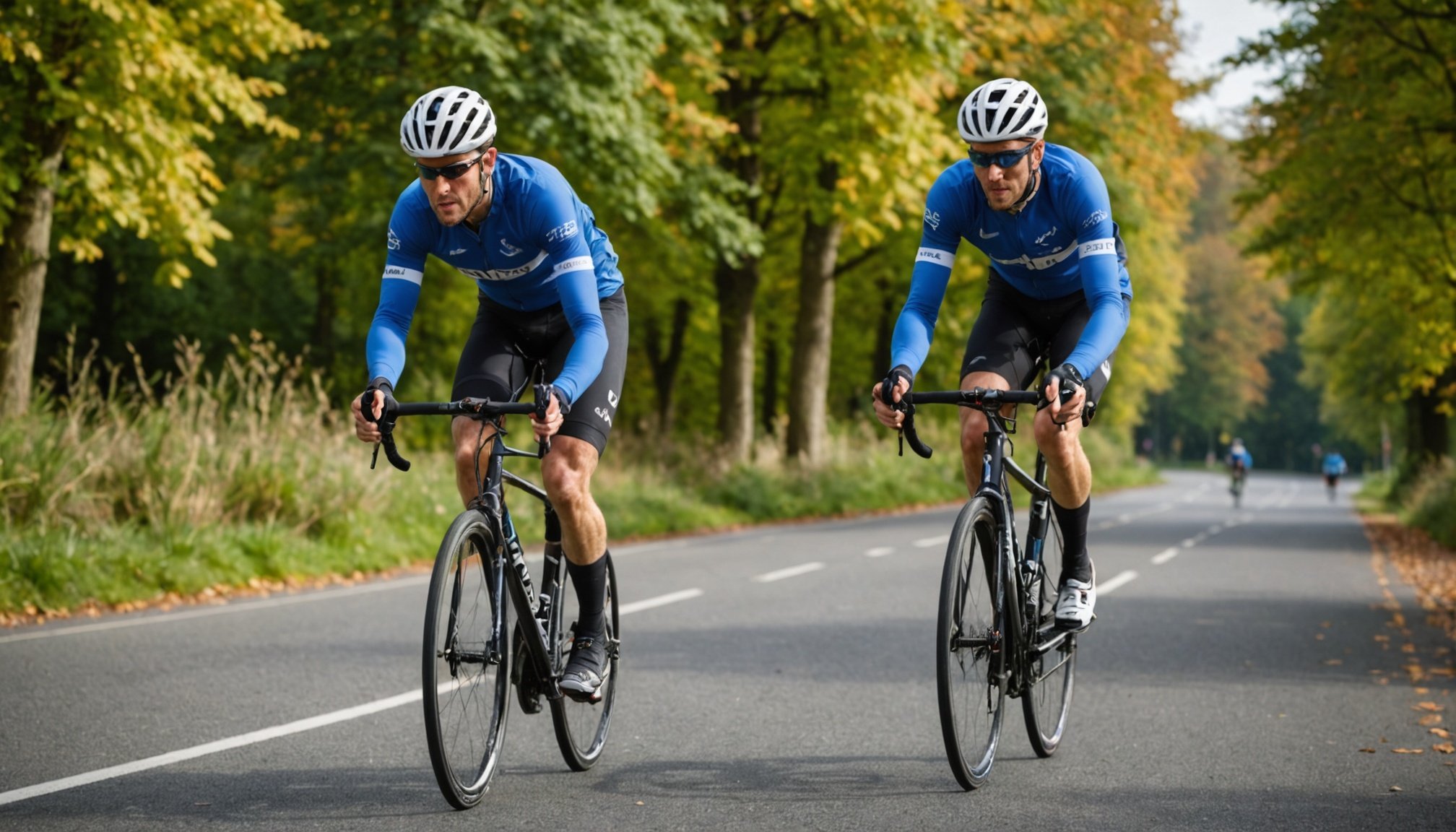Actionable Steps to Improve Cycling Endurance in the UK
Improving cycling endurance requires careful planning, especially for UK cyclists facing variable terrain and weather. One foundational principle is progressive overload: gradually increasing training intensity or duration to stimulate stamina gains without risking injury. For example, a rider might extend long-distance cycling sessions by 10% weekly.
Adaptation to the UK’s winding hills and frequent rain calls for a tailored approach. Incorporating rides on hilly routes builds leg strength and simulates race conditions, while training in wet or windy conditions enhances resilience. UK cyclists should also practice pacing strategies to handle changing terrain efficiently.
Also to read : How can beginners start their sport biking journey in the UK?
Balancing workouts with both interval and steady-state rides is crucial. Interval training involves high-intensity efforts followed by recovery, boosting aerobic capacity and speed. Conversely, steady-state rides at moderate intensity improve endurance by enhancing metabolic efficiency. A typical weekly schedule could alternate these sessions to avoid burnout while steadily improving stamina.
By following these steps, British cyclists can optimize their endurance training, maneuver local conditions confidently, and better prepare for long-distance cycling challenges.
Have you seen this : How Does Cycling Transform Urban Mobility in the UK?
Nutrition and Hydration Strategies for Long UK Rides
Proper cycling nutrition is essential for sustaining energy during long UK rides, where weather and terrain can be unpredictable. To maintain performance, aim to consume 30-60 grams of carbohydrates per hour. This steady intake helps prevent energy dips and muscle fatigue. Consider portable, easy-to-digest snacks such as rice cakes, bananas, or energy bars rich in carbohydrates but low in fat and fibre to avoid digestive discomfort.
Hydration for cyclists in the UK requires attention to the often-variable climate. Despite the cooler temperatures, dehydration remains a risk. Drinking 500-750 ml of fluid per hour is advisable, but always adapt based on sweat rate and weather conditions. Incorporating electrolyte drinks can replace sodium and potassium lost through sweat, especially in warmer summer rides, thereby reducing cramp risks.
UK athletes often rely on familiar, accessible foods for fueling long rides—porridge before a ride offers sustained energy, while sandwiches with lean protein and carbohydrates supply recovery nutrients post-ride. Additionally, many cyclists prefer diluted fruit juices or flavoured water to enhance hydration taste and encourage consistent intake.
Prioritising these tailored hydration and nutrition strategies will help cyclists meet the demands of long UK rides effectively and enjoyably.
Equipment and Gear Choices to Support Endurance
Choosing the right cycling equipment is crucial for UK riders tackling long-distance rides. A sturdy frame with reliable gearing, such as a bike equipped with a wide range of gears, helps handle the varied terrain common in the UK. Lightweight materials enhance endurance by reducing fatigue during extended rides. When planning a long-distance bike setup, focus on durability and comfort; features like ergonomic handlebars and a comfortable saddle can substantially improve performance.
Cycling clothing UK riders rely on must adapt to frequent changes in weather. Layering is key: breathable base layers wick moisture, while waterproof jackets shield against rain. High-visibility apparel increases safety during misty or low-light conditions frequently experienced in the UK’s climate. Prioritize clothing made from flexible, quick-drying fabrics that maintain comfort regardless of changing temperatures.
Accessories round out the setup, with essentials including helmets, gloves, and protective eyewear. Puncture-resistant tyres and quality lights enhance both safety and reliability on UK roads. Overall, investing in equipment and gear tailored to local conditions optimizes endurance, allowing cyclists to focus on the ride ahead with confidence and comfort.
Planning Effective Routes and Using Local Resources
When preparing for long-distance cycling, selecting UK cycling routes that balance endurance with safety is crucial. Prioritise safe routes with low traffic and suitable terrain to avoid strain and maximise performance. The UK’s diverse landscape offers varied options, from coastal paths to countryside lanes, ideal for endurance cycling. Understanding local laws, such as helmet requirements and cycle lane usage, ensures compliance and safety throughout your ride.
Joining local cycling clubs is valuable for both beginners and seasoned riders. These clubs offer group rides that foster motivation and provide insight into the best UK cycling routes unknown to many. Beyond camaraderie, group rides enhance navigation skills and help you learn pacing strategies essential for long-distance events.
Endurance cyclists can further benefit by participating in UK-based endurance cycling events. These events provide structured environments to test stamina while connecting with like-minded cyclists. The clubs hosting these rides often share practical advice on training and equipment, creating a supportive community that boosts confidence and readiness for any long haul. Embracing local resources enriches your cycling experience and sharpens your endurance skills effectively.
Sample Endurance-Building Routine for UK Cyclists
Building endurance requires a well-structured endurance training plan tailored to cycling demands. A typical cycling workout routine for UK cyclists emphasizes progressive overload while balancing rest to prevent burnout.
Start with a step-by-step guide:
- Monday: Moderate-intensity ride for 45 minutes to 1 hour, focusing on maintaining a steady pace.
- Wednesday: Interval training with 4-6 bursts of high effort lasting 2-3 minutes, followed by equal rest periods.
- Friday: Longer, slow-paced endurance ride lasting 90 minutes to 2 hours to develop stamina.
- Sunday: Recovery ride of 30-45 minutes or complete rest to allow muscle repair.
Incorporate rest days strategically for adaptation. Tracking progress is essential; monitor distance, time, and perceived effort. When the routine feels less challenging, increase intensity by adding intervals or extending ride duration. This gradual progression in your endurance training plan boosts aerobic capacity without overtraining.
Consistent evaluation ensures your cycling workout routine remains effective, enabling steady advancement toward peak endurance. This approach suits UK cyclists aiming for improved long-distance performance while managing recovery efficiently.
Expert Tips and Adaptations for British Weather
Cycling in the UK presents unique challenges due to unpredictable weather, especially rain. Cycling tips UK experts agree that a resilient mindset is key to effective training rain or shine. Accepting wet conditions as part of the routine helps cyclists maintain consistency and build endurance.
Layering is crucial for comfort and performance during cycling in rain. Start with a moisture-wicking base layer to keep skin dry, add thermal mid-layers for insulation, and finish with a waterproof, breathable jacket. Expert cycling advice highlights the importance of adjustable layers to regulate body temperature throughout variable weather conditions.
Equipment also requires adaptation. Fenders can prevent splashes, while water-resistant gloves and shoe covers ensure extremities stay warm and dry. Reflective gear is recommended for visibility on gloomy days, an essential safety measure in the UK.
Local cyclists often emphasize training routes with shelter options or urban circuits for quick weather escapes. Expert advice suggests mixing indoor trainers and outdoor rides to handle sudden rain, maintaining stamina and skill year-round. These weather adaptations enable confident, enjoyable cycling despite the challenging UK climate.



